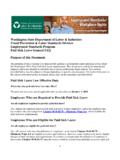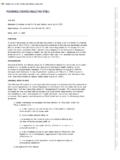Transcription of confident parent . . .” the state must be a looked …
1 To deliver the best forlooked after children,the state must be aconfident parent .. IN LOCO PARENTISE xecutive SummaryCelia HannonClaudia WoodLouise BazalgetteComparisons between looked after children and the rest ofthe population have consistently shown that care leavers areone of the most vulnerable and disadvantaged groups insociety. But assuming that the care system is whollyresponsible for this disadvantage, and is therefore failing allthose who enter care, is both overly simplistic and counter-productive. Through an in-depth review of existing data and researchstudies,In Loco Parentisshows that there are a number offactors that influence outcomes among children in care, notleast their pre-care experiences; and that looked -afterchildren, far from being a homogeneous group, enter care fora variety of reasons and have very different needs.
2 Using newquantitative analysis of the costs associated with good andpoor care journeys, In Loco Parentisdemonstrates thesignificant gains to be made by minimising delay and drift,promoting stability in placements and supporting youngpeople s transitions to adulthood. Drawing on primary research with looked after children,care leavers and foster carers as well as case studies of goodpractice cross the UK, the report sets out recommendationsto de-stigmatise care as a source of family support and taper the edges of the system so that care is not used as an all-or-nothing intervention. The report demonstrates that whatmatters most is building a care system which is sufficientlyproactive and responsive to provide the right kind of supportfor children and their families at every Hannon is head of the Capabilities Programme atDemos.
3 Claudia Wood is an associate of Demos. LouiseBazalgette is a researcher at Loco Parentis |Celia Hannon Claudia Wood Louise BazalgetteISBN 978-1-906693-46-6 10 Demos2010 InLoco cover - exec 6/21/10 1:03 PM Page 1 Executive summaryExecutive summaryIn media debate and policy discussions the care system isfrequently described as failing. This negative view of care inEngland and Wales is closely related to how it is evaluated andthe way that data on young people s outcomes is misinterpreted both of which tell a misleading story about its impact. Inreality, there is a dissonance between the evidence on the impactof care, and the public perception of the system.
4 Currently, thisstigmatisation of the care system, combined with concern aboutthe upfront costs to the state , means that some children whomight benefit from the care system do not do enter care for a variety of reasons and go on tohave very different journeys while they are there. If the caresystem is to be successful, it needs to be flexible and responsiveenough to address the needs of individual children, their carersand their birth families. When the care system is used effectivelyin this way it can be a powerful tool for improving the lives ofvulnerable children and young strong body of evidence and our own primary researchshows the most positive experiences of care, and the bestoutcomes for looked -after children, to be associated with thefollowing three factors: early intervention and minimum delay stability during care supported transitions to independenceIn this report we will consider what the care system wouldlook like if it were reconfigured to avoid the delay, instability andabrupt transitions that many young people still experience.
5 Wego on to show that this type of system could also be less costly tothe state in both the short term and over the long 1 The purpose and the impact of careBroadly speaking, there has been a pendulum movement in the history of the care system between two approaches. The firstapproach sees the purpose of care as supporting families andenabling children to remain with or return to their birth parents(a preventative approach). According to the second approach,the purpose of care should to be to safeguard children andprovide them with permanency beyond the birth family (a permanency approach). Both of these philosophies are rootedin the idea that children s exposure to public care should practice there will always be a group of children forwhom prevention from entering care or permanent solutionssuch as adoption are not realistic outcomes.
6 Instead of oscillatingbetween these positions of prevention and permanency weshould aim to use public care far more proactively to:Executive summary provide support to families as soon as they need it rather thanwaiting until they reach crisis point achieve early permanency for those children who cannot returnto their families provide stability for those children and young people for whom apermanent solution is not desirable or feasibleThe care populationChildren enter care for a variety of reasons and have verydifferent needs and characteristics when they arrive. If we are to understand the many purposes served by the care system, we must be aware of the heterogeneous nature of the carepopulation: Over the past 30 years, the numbers of children in care inabsolute terms has gradually fallen.
7 Between 1994 and 2004there was a slight rise in the number of children in care; this wasdue to fewer children entering care but those that did tending tostay for longer. A number of factors indicate there is a high concentration ofdisadvantage in today s care population. The care careers and placements of children vary considerablyaccording to the age of the child and their age at entry, theirreasons for entry, and their behaviour and needs. Many children entering care are over the age of 10, and manywill only have a short stay in care. Consequently, a child s pre-care experience is one of the most important influences on theircare journey. Evidence suggests that many of the children andyoung people who eventually become looked after already have ahigh level of mental and physical health problems at their pointof entry to summaryThe complex makeup of the care population reaffirms therange of purposes the system serves and the limitations inherentin pursuing a one size fits all care fail ?
8 Society s view of whether care is, at the most simplistic level, good or bad exerts considerable influence over the use of carein practice. The mistaken belief that care consigns all looked -after children to a lifetime of underachievement and pooroutcomes creates a culture of uncertainty, increasing delay andleading to instability later on. To challenge these misconceptionswe need to recognise the following: The way that we measure and present looked -after children s outcomes is flawed. There is now a substantial body of academic evidence thatprovides a longer-term and more nuanced perspective on looked -after children s lives, taking into account the nature of their pre-care experiences and comparing them with more appropriatecontrol groups.
9 This evidence shows that care can be a positive intervention formany groups of , care clearly serves some groups of children better than others. Rather than focusing on preventing entryinto care in cases where that might not be in the best interests ofthe child, we should differentiate between types of care journey and identify the factors that do impact on children 2 What works for children in care?Child development literature tells us that if children are todevelop in a psychologically healthy way and develop theimportant character traits and skills they need to succeed in life(such as application, self-regulation, empathy and resilience),they need to experience.
10 Executive summary a secure attachment authoritative parenting that provides a combination of responsiveness and demandingness (or warmth and consistentboundaries) stabilityA care system that promotes stability, resilience and healthypsychological development for looked -after children, should bebased around an early or decisive entry to care (whereappropriate), stable and high-quality placements that providegood parenting and are responsive to the child s needs, and asupported transition to independent or decisive entry to careAcademic evidence shows that there is a strong associationbetween children s age of entry to care, the likelihood that theywill experience emotional and behavioural difficulties and theirchance of achieving stability in care.
















